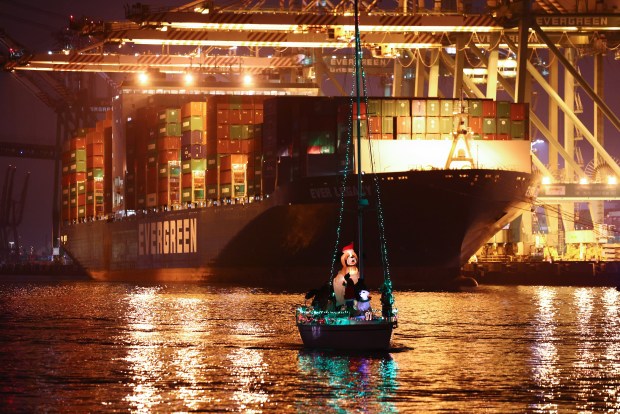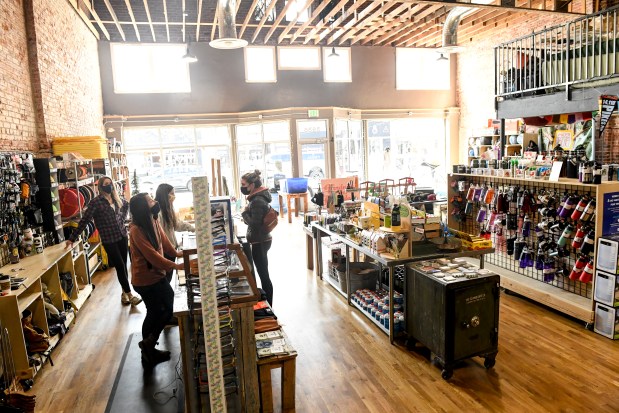Fertilizer. Tractor tires. Bins, boxes and pallets. Those are all items on Michael Hirakata’s shopping list, not for the holidays but for next year.
They were all items in short supply or much pricier than usual this year because of disruptions and backlogs in the global supply chain, and the Rocky Ford farmer is planning ahead for next season.
“I’ve never ever seen anything like this before,” said Hirakata, whose family has farmed in southeastern Colorado for five generations.
Warnings about empty shelves and scarcity of trappings of the holidays — Thanksgiving turkeys, Christmas trees — haven’t all panned out. But even as some of the kinks in the supply chain have loosened, others stubbornly stay snarled.
And inflation, labor shortages and a lack of enough truck drivers to haul goods from ports to stores and warehouses are expected to persist well into the new year. Heading into 2022, it’s unclear how the fast-spreading omicron coronavirus variant will affect business.
At Hirakata Farms, a shortage of boxes, bins and pallets needed for cantaloupes, watermelons and pumpkins this past growing season slowed work. People stopped picking until the items showed up.
Transportation was a big problem when Hirakata needed to move produce to the Front Range and other markets. The farm lost some of its produce because of the delays.
“We were waiting and just calling as many different logistics companies that we could,” Hirakata said. “We’d call our buyers and say, ‘We can’t find any trucks.’ The bad thing is they said it’s happening all over the United States, so you do what you can do.”
Hirkata is also facing higher energy prices, a 100% cost spike for fertilizer and long waits to replace tires for the tractors.
Trouble getting goods from factories to suppliers and store shelves erupted quickly after the coronavirus pandemic began. Outbreaks of COVID-19 shut down plants, reduced the number of workers at shipping ports and worsened a trucker shortage that started before the pandemic.
Shipping companies cut their capacity in anticipation of a drop in demand that didn’t happen, The New York Times reports. Ports are now clogged with items that need to be unloaded. Shipping containers are hard to find and are expensive. And there aren’t enough truckers to haul the goods to their destination.

Mario Tama, Getty Images
A holiday themed boat parades past a container ship at the Port of Los Angeles during the ‘Los Angeles Harbor Holiday Afloat Parade’ in San Pedro, California, on Dec. 4, 2021. The 59th annual boat parade marking the start of the holiday season featured boats of various sizes competing for awards. A backlog of aging cargo at the ports of Los Angeles and Long Beach has decreased 37 percent since last month.
Kinks in supply chain remain
“We’re still having a difficult time moving products throughout the U.S. The two main ports in Los Angeles and Long Beach still have a significant amount of ships waiting to be unloaded,” said Patrick Penfield, a professor of supply chain practice at the Whitman School of Management at Syracuse University.
Looking ahead, Target, Walmart and other large retailers chartered their own ships to make sure their shelves were stocked for the holiday season, said Zac Rogers, assistant professor of supply chain management and logistics at Colorado State University.
“Everything seems to be mostly on the shelves,” he added. “Companies poured a tremendous amount of resources and planning into stocking up much earlier to a greater extent than they would normally.”
Shoppers helped by starting early to try to ensure they could find what they wanted. Retailers spread out deals to encourage the early birds.
“I think we moved from Black Friday to Black Fall so they wouldn’t have giant spikes where they would have difficulty making deliveries on time,” Rogers said.
Still, out-of-stock messages on web sites are up significantly from 2019, Rogers added. And planning ahead doesn’t always help. An ongoing shortage of semiconductors means electronic items and some kinds of cars and trucks aren’t as available as they used to be.
Early in the pandemic, automakers cut their orders for the semiconductor chips because they expected sales to drop and semiconductor production lines shifted to other products. Then auto sales rebounded quicker than expected.
“I do think we’ve sort of hit the bottom in terms of mismatch between supply and demand. Things have been put in motion to build more capacity,” Rogers said. “It’s just that we’re so far in the hole that it will take us some time.”
While large companies have been able to beef up inventories, smaller retailers and companies are struggling to meet customers’ demand because of labor shortages and transportation troubles, Penfield said. Bakeries are dealing with scant supplies of cream cheese, peppermint, jellies and jams.
Other scarce items could tamp down the New Year’s revelry.
“A shortage of cans and glass could impact your wine, spirits and beer choices,” Penfield said.

AAron Ontiveroz, The Denver Post
Teya Pomeranz checks out Feral on Tennyson Street on Wednesday, April 14, 2021. At the time outdoor shops were experiencing trouble stocking full inventory because of supply chain problems.
Find everything you were looking for?
People often have to wait a few months for things like appliances and home goods, said Dawn Thilmany, a professor of agricultural and resource economics at Colorado State. Smaller companies have concentrated on a more narrow selection of products to be able to fulfill orders.
“It’s rare that you see totally empty shelves anymore. That was an early phenomenon,” Thilmany said. “Now, what you’re seeing is more limited availability of certain brands, products or supplies.”
Jason Sharpe, CEO of Namaste Solar, has experienced plenty of delays and problems finding certain supplies for the solar installations the Boulder-based company builds. He used to be able to buy certain supplies at local stores, including circuit breakers with computer chips .
“Breakers are usually on the shelf. You can go to your local hardware store or we can order from our supply house and just have them on the shelf,” Sharpe said. “Now, they’re more like four months” to order.
Namaste has had to plan more in advance and warehouse more materials. Some projects, especially ones that are more customized, have been delayed while the company waits for parts.
“I would say the smaller your business is, probably the more impacted you would be,” Sharpe said. “You might not have the cash flow or the warehouse space to plan in advance. Plus it takes people power and that costs money, too.”
Sharpe isn’t sure when Namaste will receive products it needs for a couple of projects. He was told they would arrive in the United States by mid-December. “We have no idea what month it will really make it to Colorado.”
Shipping costs have soared. Sharpe said a shipping container used to be $4,000 to $5,000. “Right now we’re seeing $25,000 to $30,000 per container,” he said.
Demand is also high, Sharpe said. Namaste had a record November in terms of leads and sales. The company is looking for more employees to help with the surge in business.
As part of a team that publishes a national monthly survey of logistics managers, Rogers tracks the kinds of issues Sharpe is dealing with to establish trends and information for the industry. The Logistics Managers’ Index compiles responses from a few hundred people about prices and capacity.
An aggregate of prices for transportation, inventory and warehousing in November showed the highest-ever rate of growth in the survey’s five years, Rogers said. The results are scored on a scale from 0 to 300, with anything over 150 indicating growth. The result in November was 271.1. The aggregate price has been over 250.0 for nine consecutive months.
“Even with some capacity coming on, prices are going to continue to be high at least through the next 12 months because of how much of a deficit we’re in,” Rogers said.
Outbreaks of COVID-19 continue to be an issue, Rogers added, especially in some East Asian countries that are important links in the global manufacturing chain.
“Here in the U.S., it’s really the question of ‘Should I take the vaccine or not?’ Vaccines are available,” Rogers said. “I think we can forget that in a place like Vietnam or Bangladesh, where a ton of apparel manufacturing happens, the question is ‘Are there any vaccines even available.’ ”
The shipping bottlenecks stretch across the world when plants and ports close because of outbreaks in other countries, Rogers said.
“It’s going to take a while to build up the physical logistics network, domestically and internationally, to meet demand,” he said. “Of course, more COVID outbreaks could slow that down but COVID could end tomorrow and the supply chain problems would still go on for a while.”


